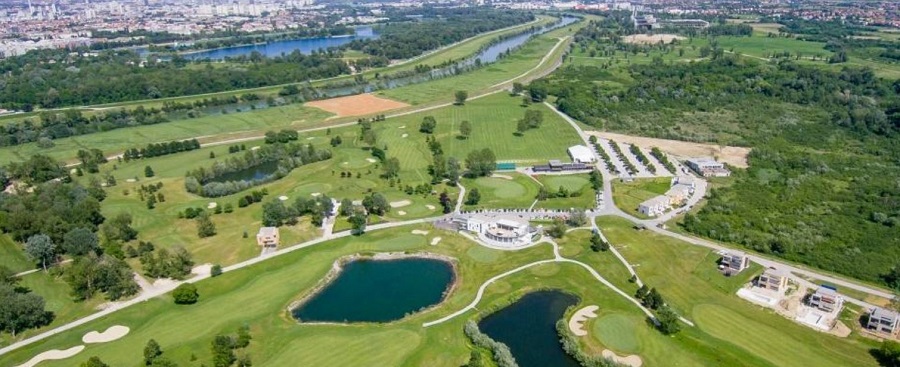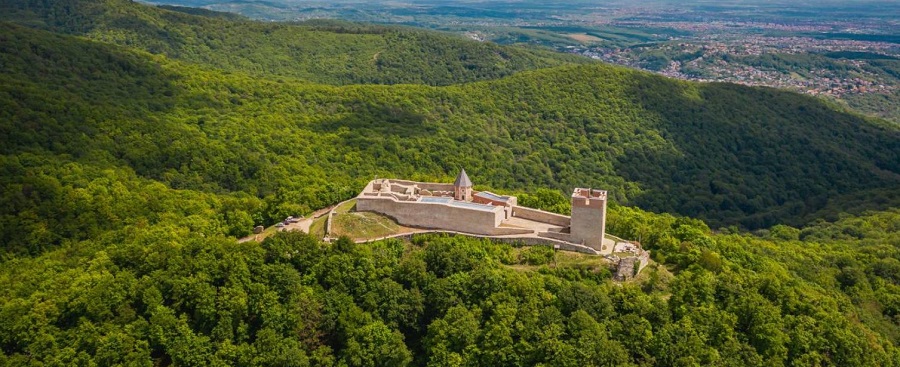Flights to Croatia: British Airways Reduces Zagreb Service
August 15, 2020 - The latest news from around Croatia’s airports for flights to Croatia with updates for Zagreb, Split, Dubrovnik.
Croatian Aviation reports that OneWorld alliance member British Airways will reduce the number of weekly flights to Zagreb in September this year.
British Airways currently operates daily between London (Heathrow Airport) and Zagreb, on A319 and A320 aircraft. Given the occupancy of the passenger cabin and reduced demand, the company decided to reduce the number of weekly flights on the said route in September this year.
From September 1 on the London - Zagreb route, British Airways aircraft will operate six times a week, every day except Wednesday, while from September 7, there will be five flights per week on the route. Namely, the flight will be additionally canceled on Tuesdays.
Changes are certainly still possible, but unfortunately not in the direction of increasing weekly flights, especially with the fact that the number of patients with COVID-19 in the Republic of Croatia is growing significantly.
Other British Airways routes in Croatia (to Dubrovnik, Split and Pula) have no operational changes so far.
Croatia Airlines currently offers three flights a week on the route Zagreb - London Heathrow throughout September (Monday, Wednesday, Friday), but the flight schedule for next month has not yet been finalized.
Furthermore, Croatian Aviation reports that Aeroflot has completely canceled the Moscow - Split route, to which it planned to return in August, and there are no announced flights to Dubrovnik or Zagreb.
Before the pandemic, Russian Aeroflot operated daily on the Moscow (Sheremetyevo Airport) - Zagreb route, both in summer and winter.
The line was suspended at the time of the pandemic and has not resumed until now. However, according to the announcements from the airline, there will be no direct flights between the two capitals this year. The company plans to make a significant restructuring after the crisis, and according to current announcements, we can expect a direct air connection between Moscow and Zagreb only in April 2021.
Aeroflot even announced the launch of its seasonal route Moscow - Split in August this year, airline tickets were already on sale, but given the regulations at the state borders, it was to be expected that flights would be canceled, which eventually happened.
The third Aeroflot line in Croatia, the one to Dubrovnik, was withdrawn from sale in March, so Croatia will not have a direct connection with the capital of Russia this year.
In the summer flight schedule, the Croatian national carrier operates on the Zagreb - St. Petersburg line, but that line was also canceled for this year.
Aeroflot's last visit to Croatia was on May 2 this year, when a B777 aircraft landed at Zagreb Airport for the first time, transporting medical equipment from China via Moscow to the Croatian capital.
For the latest travel info, bookmark our main travel info article, which is updated daily.
Read the Croatian Travel Update in your language - now available in 24 languages!
Novi Zagreb Will Have No Trams On Sunday Morning 16 August
August 15, 2020 - Replacement bus services will be the only public transport for people travelling south of the Sava tomorrow morning
A large section of Zagreb will be without trams on Sunday morning 16 August. The whole of the tram network servicing Novi Zagreb will be closed due to the installation of electricity poles.
The disruption will affect all morning trams, with normal services in most areas resuming after midday. Replacement bus services will be the only public transport available to people travelling to and from the area south of the Sava.
During the works, tram line 14 will run from Mihaljevac only to the Sava Bridge. Also, due to additional construction works near Draškovićeva Street, tram lines 4, 9 and 13 will operate with partially changed routes on the same day.
Line 4: Sava bridge - Central station - Branimirova - Branimirova tržnica - Šubićeva - Kvaternikov trg - Dubrava – Dubec
Line 9: Ljubljanica - Savska - Frankopanska - Ban Josip Jelacic Square - Trg žrtava fašizma - Borongaj
Line 13: Žitnjak - Ulica grada Vukovara - Savska - Trg bana Josipa Jelačića - Glavni kolodvor - Branimirova - Branimirova tržnica - Šubićeva - Kvaternikov trg.
Flights to Croatia: Vueling Reduces Traffic to Split and Dubrovnik
August 13, 2020 - The latest news from around Croatia’s airports for flights to Croatia with updates for Zagreb, Split, Dubrovnik, and Brac.
Croatian Aviation reports that Spanish low-cost airline Vueling has announced its flight schedule for September in which it will reduce the number of weekly flights to Split and Dubrovnik.
In July, Vueling had 14 weekly operations from Barcelona and Rome to Dubrovnik, while the number of weekly operations to Split was smaller - 12 times a week. The company will continue to operate to Split and Dubrovnik in September according to the following schedule:
Barcelona - Dubrovnik, twice a week (Tuesdays and Sundays),
Rome - Dubrovnik, twice a week (Tuesdays and Saturdays),
Barcelona - Split, twice a week (Tuesdays and Saturdays),
Rome - Split, twice a week (Tuesdays and Sundays).
In the peak season, the company had four flights a week on the Rome - Dubrovnik route, and three flights a week on the lines Barcelona - Dubrovnik, Rome - Split and Barcelona - Split. As we approach the end of the summer season, a reduction in the number of weekly flights is to be expected, so Vueling's move is not surprising.
Also, the Barcelona - Zagreb line will continue to operate in September, once a week, every Saturday evening. Vueling will thus fly to three airports in Croatia next month, with 18 operations a week.
Furthermore, Croatian Aviation reports that Croatia Airlines will still not use A319 aircraft on a regular route from Zagreb to Brac, and on charter flights from Brac to Austria (Graz and Linz).
Namely, the company previously announced an increase in capacity on these routes, given that the charterer of these charter flights requested a higher capacity aircraft. From the end of August, Croatia Airlines planned to use an A319 aircraft every Saturday on the regular domestic route Zagreb - Brac due to the positioning of the aircraft at this airport, from where charter flights to Graz and Linz were to be made.
The national company conducted training flights with this type of aircraft in the airspace around the island of Brac on July 11 this year, preparing for regular operations.
The mentioned flights were not canceled. Croatia Airlines will continue to operate on a regular route from Zagreb to Brac, as well as on charter routes from Brac to Graz and Linz, but with a capacity of 76 seats (DashQ400).
Recall, German Sundair announced a regular charter line between Frankfurt and Brač, but that line was also canceled.
For the latest travel info, bookmark our main travel info article, which is updated daily.
Read the Croatian Travel Update in your language - now available in 24 languages!
Join the Total Croatia Travel INFO Viber community.
Flights to Croatia: LOT Plans to Operate 8 Lines to Croatia in September
August 12, 2020 - The latest news from around Croatia’s airports for flights to Croatia with updates for Zagreb, Split, Dubrovnik, Zadar, and Rijeka.
Croatian Aviation reports that Polish LOT airlines have announced its flight schedule for September this year, in which it intends to fly on eight international routes to five Croatian airports. We bring you the flight schedule below.
Lines from Warsaw to Rijeka and Zagreb
The Warsaw - Zagreb line continues to operate daily in September, on E170 and 175 aircraft, with a capacity of 70 and 82 seats, respectively.
The Warsaw - Rijeka line will be in operation until September 13, once a week as before, on Sundays. In September, smaller capacity aircraft will operate on the route. The line was originally scheduled to run until October 18, but the company will close it in the middle of next month.
LOT lines to Split
Of the currently active LOT lines to Split, only one will operate in September. The Warsaw - Split line continues to operate once a week throughout September, every Sunday, with aircraft type B737-800 and E195. The following lines end in August:
Lublin - Split will be in traffic until August 28, once a week (Friday),
Katowice - Split will be in operation until August 30, once a week (Sunday),
Poznan - Split will be in operation until August 31, once a week (Monday).
Gdansk - Split will be in operation until August 26, once a week (Wednesday).
Two lines to Zadar
LOT will keep traffic on two lines in Zadar through September; the Warsaw - Zadar line continues to operate once a week, every Saturday, as well as the Rzeszow - Zadar line, which will operate until September 19, also on Saturdays. The following LOT lines end in August:
Gdansk - Zadar will be in operation until August 28, once a week (Friday),
Szczecin - Zadar will be in operation until August 27, once a week (Thursday),
Krakow - Zadar line will be in operation until August 25, once a week (Tuesday),
Bydgoszcz - Zadar line will be in operation until August 29, once a week (Saturday).
Three lines to Dubrovnik in September
LOT will keep three lines to Dubrovnik in September this year, two from Poland and one from Hungary. The Warsaw - Dubrovnik line will operate four times a week (Mondays, Wednesdays, Thursdays and Saturdays), the Krakow - Dubrovnik line once a week, on Saturdays, while the Budapest - Dubrovnik line will operate once a week, on Sundays, until September 27.
The following LOT lines will not operate in September this year:
Katowice - Dubrovnik will be in operation until August 27, (Thursday),
Poznan - Dubrovnik will be in operation until August 30, (Sunday),
Wroclaw - Dubrovnik will be in traffic until August 29, (Saturday),
Gdansk - Dubrovnik will be in operation until August 25, (Tuesday).
Of the 20 currently active lines to Croatia, the Polish national company will operate only eight next month.
For the latest travel info, bookmark our main travel info article, which is updated daily.
Read the Croatian Travel Update in your language - now available in 24 languages
International Street Festival Cest Is d'Best to Start Aug 19
ZAGREB, Aug 9, 2020 - The Cest is d'Best international street festival will this year be held from August 19 to 23, and its 24th edition will offer hundreds of hours of programmes featuring various musicians, performers and artists.
Cest is d'Best is the oldest and biggest street festival in Croatia, taking place in Zagreb since 1997, and in the last dozen years it has greatly expanded its programme and become an important international festival as well, the organisers have said.
This year's partner country is India, so a part of its culture will be presented at the very beginning of the Cest is d'Best festival, on Wednesday, August 19.
There will be art, ecology, and educational workshop for the youngest visitors, while all visitors will be able to learn basic circus skills, such as juggling, hooping, tightrope walking, and aerial silk dancing.
Theatre, puppet, and circus performances will be organised for children, and all visitors will have access to sports equipment for recreation and entertainment on the grass.
Attending the festival this year will be about ten artists from abroad and around a hundred local musicians, painters and performers.
This year a race for dogs and their owners will again take place as well as a garbage men race.
The organisers have underscored that there will be an interesting selection of food, with an emphasis on healthy food.
350 Colourful Flags Will Cover Zagreb At New International Flag Festival
August 7, 2020 - Trg Bana Josipa Jelacica, Zrinjevac, Europski trg and Ul. Augusta Cesarca will bloom brightly with banners at the International Flag Festival next week
Zagreb will erupt with colour this August as the city welcomes its first International Flag Festival. Ban Jelačić Square, Zrinjevac park, Europe Square and Ulica Augusta Cesarca will be covered in eye-catching banners made by artists from Argentina, Uruguay, Finland, Russia, India, Italy, Canada, USA, Croatia, Bosnia and Herzegovina, Serbia, Montenegro and Slovenia.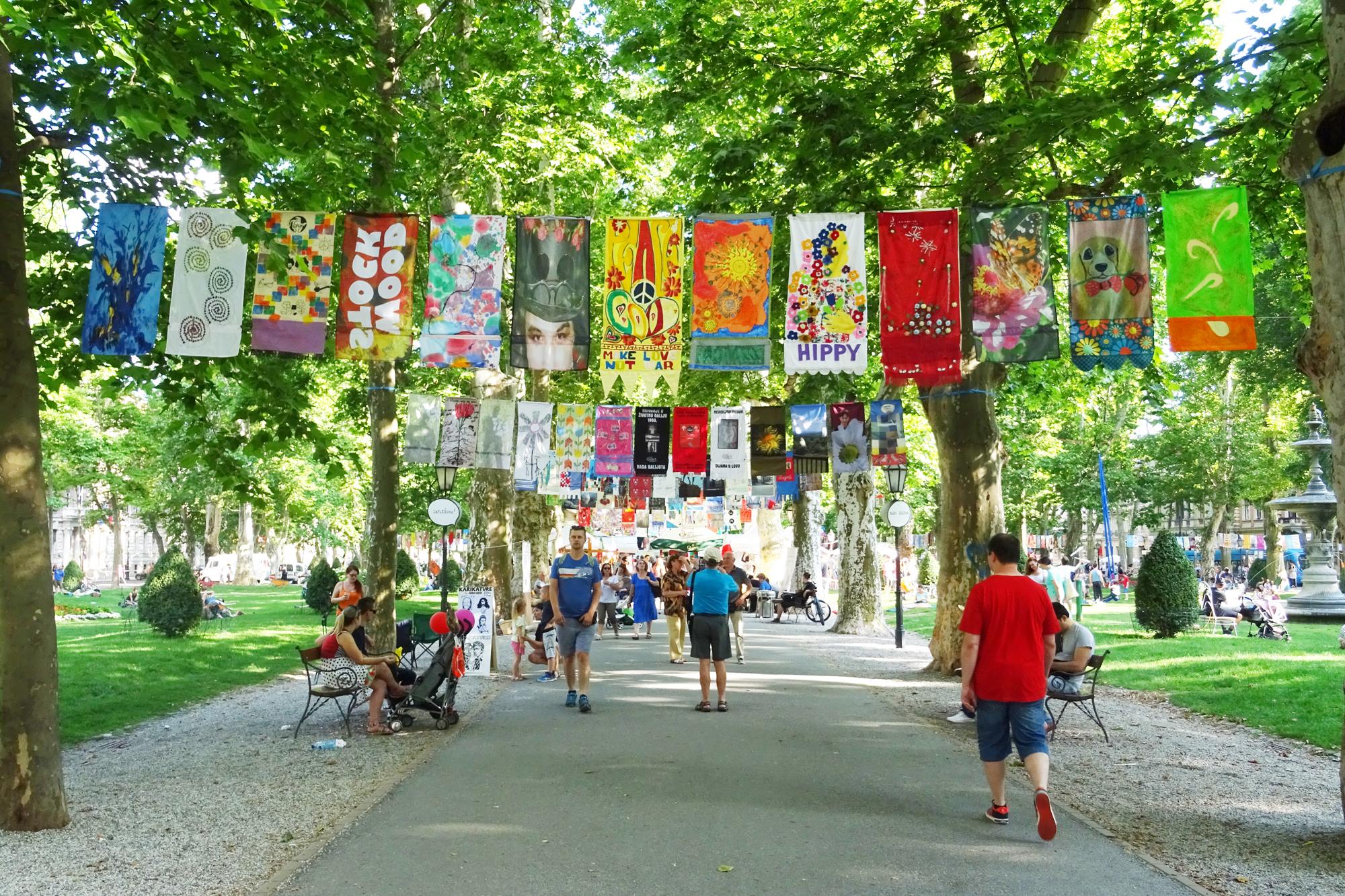
© Međunarodni festival umjetničkih zastavica /
Trial runs for the International Flag Festival have taken place in previous years as part of the popular Cest Is d’Best Festival. However, the adornments have proved such a popular addition to city parks and streets that the run of flags has been expanded and given its own dedicated event.
Artists from over 20 countries will take part in this year’s inaugural event. The theme for the 2020 edition is European Identity and Europe Intimately. Each artist will deliver their own vision of what Europe means to them.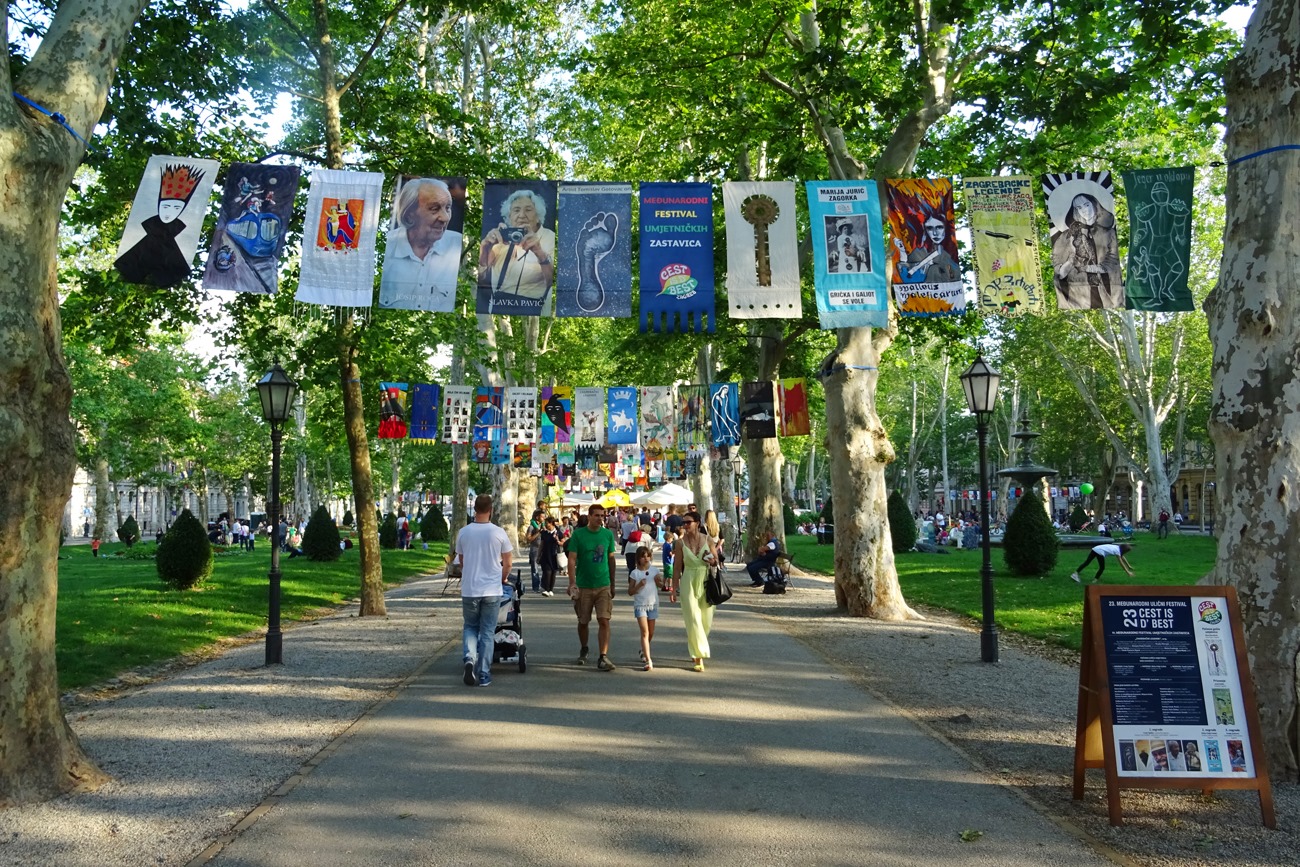
© Međunarodni festival umjetničkih zastavica / International Flag Festival
Keep an eye out for the festival of flags in the Croatian capital from Monday. It’s doubtful you’ll be able to miss the wonderful display! The International Flag Festival runs from 10th August to 20th August.
Flights to Croatia: Aegean Airlines Cancels All Flights to Croatia in 2020
August 5, 2020 - The latest news from around Croatia’s airports for flights to Croatia with updates from Zagreb, Split and Dubrovnik.
Croatian Airlines reports that Aegean Airlines, a Star Alliance member, previously announced the start of traffic to three Croatian airports (Dubrovnik, Split and Zagreb) from September this year. All flights to the mentioned destinations have been canceled for this year.
Before the pandemic, Aegean Airlines planned to operate to three destinations in Croatia from Athens (Eleftherios Venizelos Airport). The start of traffic was first postponed to September, and now all flights to Croatia have been canceled for this year.
Lines to Zagreb, Split and Dubrovnik were supposed to operate with a smaller number of weekly flights compared to last summer season, but due to weak demand, the company completely canceled flights on these routes and does not intend to launch them this year.
This left the airports in Split and Zagreb without a direct connection with the Greek capital. Croatia Airlines operates on the route Zagreb - Athens with a stop in Dubrovnik, so the flight between the two capitals is not direct. The Zagreb - Athens (via Dubrovnik) route of Croatia Airlines continues to operate three times a week, every Tuesday, Thursday and Sunday on the DashQ400 aircraft, with a capacity of 76 passengers.
It should also be mentioned that Volotea also canceled flights from Dubrovnik and Split to Athens until the end of the summer flight schedule.
Furthermore, Croatian Aviation reported that as of Sunday, August 2, Turkish Airlines is operating fewer weekly flights on the Istanbul - Zagreb route.
In July, Turkish Airlines operated five times a week on the Istanbul - Zagreb route, but since the beginning of August, there has been a reduction in the number of weekly flights. Throughout August, the company will operate on the mentioned line only four times a week, every Monday, Wednesday, Friday and Sunday, flights will take place on Mondays and Fridays in the evening, and Wednesdays and Sundays in the morning.
Smaller capacity aircraft (mainly A319) have been announced on the route. It is worth mentioning that before the outbreak of the pandemic, Turkish Airlines flew to Zagreb twice a day, transporting a large number of passengers from Asia, and these tourists are almost non-existent in Croatia this year. The company has repeatedly adjusted its capacity on the line by introducing larger aircraft, such as the A330, but this will probably not be necessary this year.
The second line of Turkish Airlines in Croatia, to Dubrovnik, was previously announced for September. However, all flights have been postponed and the company is currently offering flights in October, though they will soon be canceled. In fact, Turkish Airlines will not return to Dubrovnik Airport this year.
For the latest travel info, bookmark our main travel info article, which is updated daily.
Read the Croatian Travel Update in your language - now available in 24 languages
International Cuisine In Zagreb: Royal India
August 3, 2020- Continuing our series on Zagreb’s international food offer and the stories behind these cuisines and businesses. This time, from Punjab to Tkalčićeva; Royal India.
Royal India in the heart of Zagreb is the longest standing restaurant that sells Indian food. Like its chefs, owner Satinder comes from north India, the area’s distinct cuisine of spicy curries, oven-baked and marinated meats, and inviting breads synonymous with the Indian restaurant offer around the world.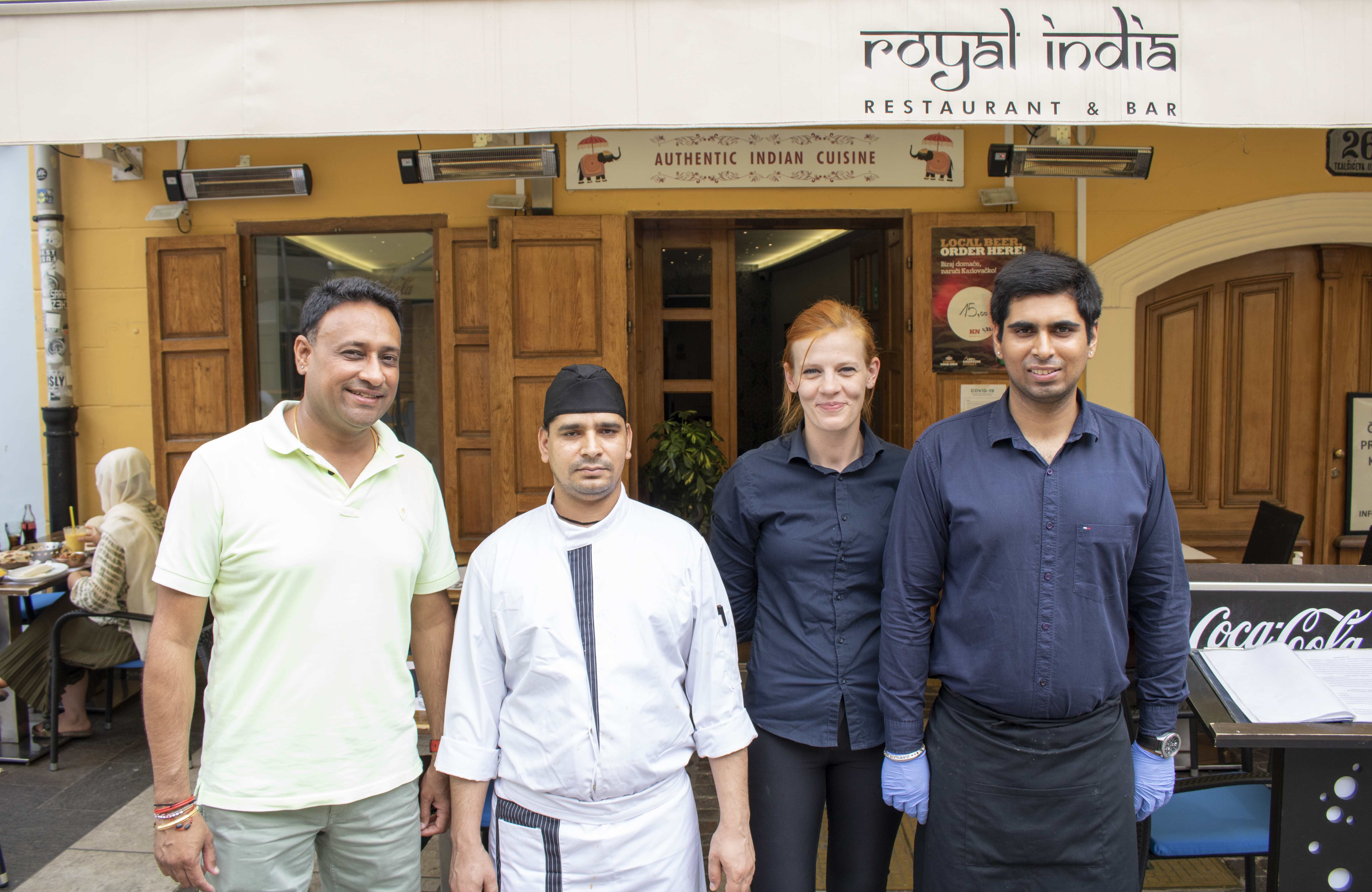
Satinder Pal Singh (far left) and some of the staff of Royal India © Vedran Pažin
My name is Satinder Pal Singh. I’m from the northern part of India, a city called Chandigarh. It’s the capital of Punjab and Haryana. It’s near New Delhi. I say near, it’s 250 kilometres away.
Here at Royal India we serve authentic Indian food. Mainly we concentrate on food from north India. The food from the north is totally different from food in the rest of India. In the south, the kitchen is totally different; dosas, fish. If you eat Indian food anywhere else in the world, 99% of the time you will be eating recipes from the north of India. It’s the most popular cuisine of India. We have a lot of different kinds of curries – chicken, lamb, and many vegetarian dishes - chicken tikka butter masala is the most popular one we make at Royal India. Northern India cuisine also comes with more bread than that in the south - naan breads made plain, with meat, with onion, with garlic, and chapatis. We always use Basmati rice. Only. That is very typical of Northern India. They use long grain rice in the south. Basmati rice has the best aroma, flavour, and texture (this is true – Kitchen Editor). We use Basmati rice because it grows in the north.
We use very different spices and flavours in Northern India cuisine. In the south, they use curry leaves, coconut, things like this. We use cardamom, cumin, fresh coriander and coriander seeds, star anise, black pepper, bay leaves, cinnamon, and a lot of spice mixes. We grind spices and mix them together in known amounts. The resulting mixture is called garam masala. We make our own specific garam masala here on the premises. We buy only whole spices. They are always the best. Whole spices stay fresh for longer and give a better aroma. The garam masala can vary from region to region. Across northern India, it is almost exactly the same. Within the restaurant setting, it depends on the chef.
Marinated, grilled meats are a specialty of northern Indian cuisine © Vedran Pažin
The biggest distributors of spices are in Germany and in the Netherlands. You just can’t find what we need in Croatia. We get our spices from them and they import directly from India, Turkey and even some parts of Africa.
We’ve been open now for six years. Our most popular dishes are Murgh Tikka Butter Masala, which is made with chicken and Lamb Rogan Josh. When I first arrived here, I saw the market and it wasn’t good. There was only one restaurant in Zagreb making Indian food back then and I wasn’t impressed. When we opened Royal India, they closed.
Croatian people seem to really like our food. We make the dishes according to their tastes; they can choose mild, medium, spicy or something more authentic. We ask. Every curry we make individually, fresh to order. Because we’re on Tkalčićeva, we also usually get a lot of international visitors. They are normally already familiar with Indian cuisine. You can tell because they order different things and they usually already know what they want to order from the menu by the time the waiting staff come to the table. Croatian people who are less familiar with Indian cuisine sometimes need more guidance around the menu, explanations and, of course, we are very happy to do that.
All of our kitchen staff are from India. They are all from the north of India. At first, when I was holding interviews, most of them did not even know where Croatia was. I had to explain. In the past, it was very difficult to get working visas for such specialist chefs. Four years ago it was tough. They had a quota system and it was first come, first served. If you were not among the first to apply for that year’s quota, you had to wait for one whole year to apply again. The quota was 31 chefs for the whole of Croatia, irrespective of origin or specialty. But, now they changed the system and we no longer have any problem. It’s much more liberal now. The implications for businessmen, foreign investors in Croatia, are greatly improved because of this change alone. The change coincided with Croatia becoming a full member of the European Union. Quite a few young Croatians have left, to take advantage of job opportunities elsewhere in Europe. The deficit of manpower prompted the change. This is how the international jobs market is supposed to work.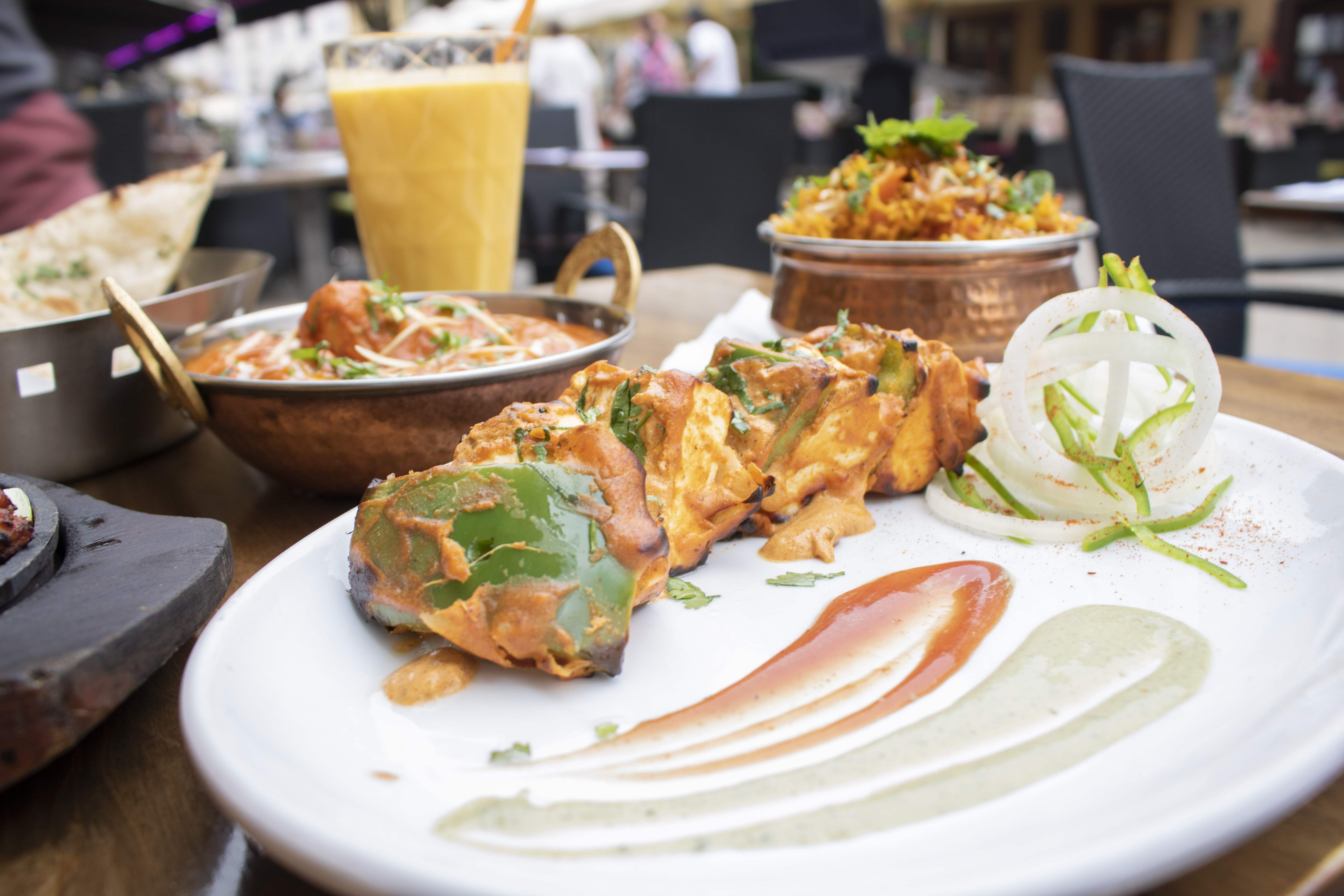
Mango lassi (a sweet yogurt drink), curry, chapati, biryani (a rice dish) and marinated, grilled paneer cheese at Royal India © Vedran Pažin
I first came to this region because of business. I was importing textiles from Bosnia. I wanted to expand the business into Croatia, but we had difficulties. We could sell our product, no problem. The difficulty was getting people to pay their invoices. So, I decided to open a restaurant instead. Here, people pay immediately, so we don’t have that problem. I couldn’t have opened this kind of business in Bosnia because the economy is so much worse there. And the locals are much more hesitant to try foreign food. In Zagreb, the people are more openminded and more well-travelled. The import and export area I was in is now populated by a lot of Chinese and Turkish businesses. There’s a lot more competition than when I was doing it. I’m much happier doing this.
I live in the centre of Zagreb. One of the best things about living here is that it’s so safe. People are really very friendly. When I have time off from the business I enjoy sitting with friends. They are mostly Croatian. It was easy to make friends here. We usually go to coffee shops or each other's homes. I normally suggest a coffee shop on Tkalčićeva, just because it’s easy for me to get back to work if I’m needed.
We didn’t do home delivery during the restaurant lockdown. Our sales went down 80% over the year as a result. I have another restaurant in Dubrovnik, Incredible India; we didn’t even open yet this year. In the season, I usually travel constantly between Zagreb and Dubrovnik. Four or five times a month. We are currently moving the restaurant to a new site in the Old Town, so construction work is happening and I must travel to oversee that. We should be opening in the first few days of August, although I haven’t seen many tourists there this year. That’s a worry. The funds for the restaurant move are coming purely from my own pocket. I will wait until the end of the year, see the situation and maybe make some decision then.
You can visit Royal India at Tkalčićeva 26
You can read the introduction to our series on Zagreb international cuisine and the first installment here
To follow our whole series on international cuisine and to follow the Croatian restaurant and gastro scene, keep an eye on our Gourmet pages here
Around Zagreb, a New Concept Leading the Way in Integrated Tourism Approach
August 3, 2020 - The new Around Zagreb website is proving a hit, as well as leading the way with a new integrated tourism approach.
The stereotype of Croatian tourism is that of sun, sea and beach. With 1,777 km of glorious Adriatic coastline and more than 1,000 islands to choose from, that is completely understandable. And yet, in the last decade, tourism in Croatia has diversified a lot, with destinations away from the coast emerging as credible holiday alternatives to two weeks sitting on the beach.
And the destination which has made the most progress in the last decade - at least in my opinion - is far away from the coast.
The capital city Zagreb.
When I first moved here back in 2002, a visit to the capital left me cold. The food was one-dimensional and there did not seem to be that much to do. And then something changed, and with that small change came more change, and then the floodgates of change came. Suddenly, Zagreb had become a very cool city, so much so that Lonely Planet even named it the Best Destination in Europe in 2017.
EU entry in 2013 helped to bring a new international aspect to Zagreb, of course, but it was innovations elsewhere that really drove the change. Innovative museums such as the Museum of Broken Relationships, the Museum of Illusions, the Museum of Torture and more recently, the Museum of Hangovers, gave Zagreb an alternative cultural side of things, its street art flourished, there was an explosion of international dining options, wine bars and a vibrant craft beer scene to add to the laganini coffee lifestyle for which Croatia is rightly famous.
It is also the only destination (again, in my opinion) that has successfully managed to extend the season in Croatia. In just a few years, Advent in Zagreb went from a nothing event to being voted the Best Christmas Market in Europe three years in a row. Its marketing adorns the trams and buses of major European cities, and thousands of foreign visitors pour into Zagreb each December to enjoy the seasonal festivities.
The corona crisis put a screeching halt to tourism worldwide, with many destinations more or less closed down. As tourism reemerged, albeit very slowly, once global lockdowns were eased, it was clear that a new approach to tourism to reflect the new normal was essential.
Which is one of the reasons I was so impressed with the new joint Around Zagreb initiative from the tourist boards of the City of Zagreb and Zagreb County. As I wrote a few weeks ago, the Around Zagreb site brings together all the outdoor activities and socially distanced opportunities available, both in the city itself, but also in the immediate vicinity of Zagreb County. You can check out the website here.
A simple idea, but one which completely changes the perspective of the destination. Something I reflected on last week during my visit to Dubrovnik. The Pearl of the Adriatic is a stunning city attraction for a couple of days, but if you market it as Around Dubrovnik, suddenly the content multiplies several times in an instant.
Suddenly, Zagreb was no longer a city, but a city with lungs and plenty of wide-open spaces offering a wealth of fun things to see and do which perhaps you would not expect to find on a visit to a capital city. Here are five that caught my eye from the Around Zagreb website, which I should add is one of the most informative and well-written official tourism websites I have seen in 10 years of following the sector:
Truffle Hunting
Truffle hunting near Zagreb? You won't find too many local who know about this. One of the great building blocks of the Istrian gourmet scene, you don't have to travel that far from the Croatian capital to take part in this very unique pastime to go in search of one of Croatia's most sought-after Croatian delicacies:
In Zagreb, mushroom hunting is a respected and popular pastime activity, so the forests around the city can be teeming with adept foragers after rain, both hobbyists and serious hunters. During the season, farmers' markets in Zagreb are full of fresh forest mushrooms, most often boletus. Yet, few people know that a real edible treasure is hidden underground on the outskirts of Zagreb – black truffles. These rare wild mushrooms grow in dense and wet forests, mostly oak and beech, common on the slopes of Medvednica Mountain. Knowledge and experience is required for truffle hunting, and since they are hidden beneath the ground, it is impossible to find them without specially trained dogs. The aromatic truffles are the tastiest when they are freshly shaved, and they are also often used to spice up cheese, honey, chocolate or honey brandy. In Zagreb you can enjoy the unique experience of guided truffle hunt, combining a forest adventure with the pleasure of tasting this exclusive treat in one of the selected restaurants in the city. Another proof that the folks of Zagreb genuinely appreciate mushrooms is the Mushroom Museum just off the main square, exhibiting more than 1500 species of freeze dried mushrooms.
Wine-tasting in the 'Champagne' capital of Croatia
So too with wine. Istria, Dalmatia and Slavonia are famous wine regions, but did you know that the city of Zagreb has its very own wine road? Or that a short drive will take you to one of the country's most diverse wine regions, famed for the best sparkling wines in all Croatia?
The Plešivica Wine Road has been open since 2001, bringing together around forty winemakers with diverse touristic attractions. There you can sample native and domesticated varieties such as Blauer Portugieser, Plavec žuti, Rotgipfler and Šipelj, along with world-renowned varieties such as Chardonnay, Riesling, Sauvignon, Gewürz and Pinot noir, blanc and gris. Wines from Plešivica win awards year after year in Croatia and all around the world.
The tourist offer of the Plešivica Wine Road can be divided into three categories: all winemakers offer wine tasting in their wine cellars, some offer homemade food along with wine tasting, and winemakers from the last category offer, together with wine and food, accommodation in strikingly furnished accommodation establishments overlooking the breathtaking “amphitheater” of Plešivica.
A round of golf, perhaps?
Golf might not be the first thing you think about when you plan a trip to Zagreb, but it is comforting for golf enthusiasts to know that there is a full 18-hole course just outside the city if they want to practice their swing one afternoon while visiting. If you come at the right time of year, you can even do a round wearing a kilt and drinking whiskey with some local lovers of all things Scottish.
The history of golf in this area is not so recent. Back in 1929, a group of enthusiasts in Zagreb dreamt about a golf course in the city, and the first practice ground was really opened in Maksimir Park, in 1931. Golf in Zagreb then vanished for a while, until the early 2000s, when a much more appropriate location near Blato, in the suburbs, opened its doors. In the spacious green field on the south bank of the Sava River, only a 15-minute ride from the centre of Zagreb, you can find Riverside Golf Zagreb. It includes a 9-hole executive course and an 18-hole championship course, as well as a large driving range with 40 bays and a chipping green, with options to practice in bad weather or at night. The attractive club house with a large terrace is the place for socialising, and there is also a restaurant at hand. Even if you don’t play and have no strong interest in golf, Riverside Golf Zagreb is a pleasant place for a short break in the outdoors, in the peaceful surroundings untypical for a big city.
The healing powers of Naftalan
Croatia has long been famous for its wellness and health tourism. Indeed, the founding of the Hvar Health Society in 1868 is credited as the birth of organised tourism in Europe.
The region surrounding Zagreb has a number of excellent wellness opportunities, including one with something that can only be found in one other place outside Croatia:
Thanks to the Pannonian Sea that used to cover parts of central Croatia, the area below Ivanić-Grad hides a true treasure: naftalan oil. Naftalan is made by distilling naftalan oil. Naftalan is petroleum mineral oil made by sedimentation of dead microorganisms' remains, and it is valuable due to its numerous healing properties. Not only is it valuable, but it is also an extremely rare natural phenomenon. It is so rare that it can only be found in two places in the world: in Azerbaijan and in Croatia. Naftalan was first found next to Ivanić-Grad in the 1960s, and in 1989, the Naftalan Special hospital for medical rehabilitation was founded. The Hospital is the only place of that kind in Europe.
Despite the fact that the commercial use of naftalan for medical purposes is a relatively new phenomenon, people have been aware of its beneficial properties for centuries. The first notes on naftalan were written by world traveler Marco Polo, but the notes referred to the sources in Azerbaijan, on the Silk Road. In Ivanić, it is successfully used to treat rheumatic diseases, spinal joint diseases, and skin diseases. The naftalan oil bath is a unique experience that has beneficial effects on your skin and body. Other than using naftalan for oil baths, experts have created special, naftalan-based cosmetic products: lotions, oils and shampoos. The products are used to complement treatments done in the Hospital, but are also available on the market.
People come to Naftalan for the powerful, black-brown oil treatment, and for the benefits of healing thermal water. Thermal water is also a remainder of the Pannonian Sea, and it is sourced 1300 meters below the ground. The salty oil water that is rich in minerals can prevent and treat numerous health issues, and is generally beneficial to the body. Regardless of its focus on a broad spectrum of health treatments, Naftalan is also a well-known wellness and spa destination. Naftalan offers accomodation with 137 beds, 26 of which come with top-standard service. A sports park near the Hospital complements everything Naftalan has to offer, and the Moslavina region, with its developed rural and wine tourism, has all merits needed to amaze the visitors who want to explore the region.
Inside the secrets of a 16th-century mine
One of the feelings one has browsing the Around Zagreb website is just how much wonderful nature there is surrounding the city, as well as its many historic buildings. And sometimes you can combine the two with a little heritage and history of yesteryear in a family outing of discovery to the 16th century Zrinski Mine, for example:
In the past, Medvednica Mountain was an important treasure of natural resources for the people of Zagreb, so they also dug deep in it, searching for precious metals. After the discovery of galena ore, a source of silver, a mine was opened in the 16th century. The hardworking miners dug and dug painstakingly, but the mine was simply not productive enough, and closed down the following century. After a few hundred years of silence, these dark and cold tunnels are now accessible to curious visitors in search of a special experience.
Five experiences from many. If you are contemplating a trip to Zagreb, I heartily recommend the Around Zagreb website for trip ideas and things that you had perhaps not thought of or known about. And the 3-day itinerary selections for family, art, nature, foodies, history buffs and romantics, are excellent.
Air Taxis Thriving in Corona Era, Zagreb's Jung Sky Records Most Successful Summer Yet
August 3, 2020 - Jung Sky, a Zagreb-based airline company operating in private, business and charter flights since 2009, is seeing a record summer thanks to the coronavirus pandemic.
Slobodna Dalmacija writes that while commercial airlines were absent on the Adriatic, this air gap has been filled by small private and business planes whose number of landings and takeoffs with tourists is expressed in hundreds per day at all airports on the Adriatic.
Usually, small private or business planes rented for transportation belong exclusively to the world of jet-setters, millionaires, wealthy athletes, and business people, which is peculiar that so many were coming to Croatia today. However, during the corona era, where travelers are looking to avoid close contact with other passengers, privacy is critical - and air taxis have become king.
Moreover, the coronavirus, which has caused trouble to almost everyone involved in anything related to travel, has brought new clients to business aviation. Demand is at very high levels, and more often than not, they are hitting record numbers. Currently, the sales department of air taxi companies receives up to 300 inquiries per plane per day!
Recently, the BBC World News reported on a record increase in the number of passengers who opted for this service for the first time this year, after the pandemic. The situation is no different in Croatia - and Zagreb-based "Jung Sky", which boasts two planes, recorded the best business results in June and July in the 10-year history of the company.
"After the number of flights dropped by more than 80 percent in April, in May the decline was halved, and the rush for the summer was slowly catching up," says Kresimir Vlasic, Jung Sky's director of operations.
June hit substantial numbers, and July is on the verge of the most successful month in the company’s history. Due to the excellent isolation conditions when traveling by private plane, in June and July, the pandemic also affected the profile of passengers.
"The dominance of business travelers is smaller, and this year a significantly larger number of tourists are flying with us than usual. Everyone is thinking about epidemiological issues and they see the right answer to their fears in our service. All indicators show that the current clientele has remained faithful to this service, but a significant percentage of passengers are using our services for the first time, and are determined to use us in the future. Traveling privately, with family and people you know well, is the epidemiologically simplest and most acceptable option, and the problem of lack of regular or insufficiently frequent airlines or congested roads is completely eliminated," Vlasic believes.
Drazen Gros, head of the operations center, said that there are different profiles of passengers using this type of service. They are most often top and middle management on business trips, families on family trips, individuals going on various business, sports or music occasions, musicians, athletes or actors, and experts of various profiles that companies send to perform specialist jobs.
There are many reasons to rent business aircraft, from organizing travel according to your needs and schedule, to saving on travel time and avoiding changing planes. There is, of course, the possibility of traveling to more than one destination, greater security and privacy during the trip, the possibility of direct arrival to smaller places that are weakly or not at all connected by regular lines and savings on travel costs in cases where more people travel. Tourist reasons are most dominant during the summer when the number of inquiries for Mediterranean destinations, including Croatia - grows," said Gros.
When asked if this is exclusively a deep-pocket clientele, i.e., the rich and famous, he added:
"No, it's prejudice. Extremely wealthy people have their own planes that cannot be put in the same category as our planes in terms of value. Just as road taxi transport has its advantages over public transport and is used by both private and business users, so air taxi transport has its advantages over regular transport. Sometimes, by using regular lines for a three-day trip, two days would be spent only on transportation, and by using a business plane, passengers travel to a meeting on the same day and return home," explains Gros.
Since such planes travel to Croatia almost exclusively by foreigners, which Croatian passengers are using these services? The interlocutors revealed that it is mainly the business community and senior management that use the services of small business aircraft due to the need for business meetings. The range of these aircraft is about 2500 kilometers, and it is possible to reach most destinations in Europe and North Africa without stopping.
So, how much does it all cost?
"The price of the service is calculated according to the total number of flight hours in the rotation ordered by the client, which includes the flight from the base in Zagreb to the destination where we pick up passengers, then the flight to their desired destination, return flight if requested by the passenger and our return to base. Prices vary by season, and some of the variables can be airport costs, use of the VIP lounge and the like. Our prices are between 1,800 and 2,200 euro per hour of flight, regardless of how many passengers are on the plane, and the planes have a capacity of six seats. The total cost of the flight is related to the total duration of the flight, and additional costs that vary from airport to airport, regardless of whether it is a return or one-way flight," said Jung Sky, which is one of about 500 such operators in Europe.
Business aviation makes up only 8 percent of the total air traffic in Europe, where there are operators that fly with only one aircraft, but mostly it is about two, five, or even a few dozen aircraft in the fleet. And they all provide passengers with a pleasant flight, whether it is a light "piston" aircraft or a large jet aircraft weighing more than 400 tons. In most cases, air taxi companies in Europe work with aircraft with a capacity of up to ten seats.
Unfamiliar with altitude and aviation topics, one might first wonder if turbulence in small business planes is greater and more frequent than in large planes that seem safer because they are, well, large. But air taxi companies argue the opposite. Namely, compared to regular commercial aviation aircraft flying at altitudes of 10-11 km, business aircraft fly at altitudes of 13,000 to 13,500 meters, so they are pleasant flights because turbulence at such altitudes is a very rare occurrence, and speed flight is up to 800 km / h.
Thus, the coronavirus pandemic, which brought so much trouble to the entire tourism and service sector and especially to the travel industry, has led to an increase in demand for business aircraft.
"This is partly because a large number of scheduled airlines have been canceled, while another key reason is the fear of traveling in large groups. The only things that have a strong impact on our traffic are the necessity of going to quarantine after arriving in a country and restrictions at airports. If April is not repeated this year, the future of business aviation is definitely bright, especially due to epidemiological issues. Traveling on a business plane not only solves the issue of staying in a cabin with strangers, but the service from start to finish allows a high degree of (self) isolation and flexibility. No waiting for a flight at airports, no standing in lines for check-in or control. It passes through a special general aviation terminal, you board the flight literally five minutes before takeoff, and the whole experience can be passed without any physical contact with other people," Jung Sky concluded.
For the latest travel info, bookmark our main travel info article, which is updated daily.
Read the Croatian Travel Update in your language - now available in 24 languages




